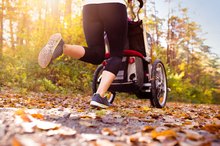What does fact checked mean?
At Healthfully, we strive to deliver objective content that is accurate and up-to-date. Our team periodically reviews articles in order to ensure content quality. The sources cited below consist of evidence from peer-reviewed journals, prominent medical organizations, academic associations, and government data.
The information contained on this site is for informational purposes only, and should not be used as a substitute for the advice of a professional health care provider. Please check with the appropriate physician regarding health questions and concerns. Although we strive to deliver accurate and up-to-date information, no guarantee to that effect is made.
Stomach Muscles After a C-Section
There are many reasons a woman may need a Cesarean section, whether planned or unplanned. Regardless of the reason for the surgery, a C-section requires a different recovery than a regular vaginal birth. Understanding the importance of keeping the stomach muscles safe after a C-section can help recovery.
If you are experiencing serious medical symptoms, seek emergency treatment immediately.
Types of Incisions
C-sections are usually performed in one of two ways, depending on the needs of both mother and baby. Most C-sections are performed with a bikini line incision, which is a low horizontal cut just above the pubic bone. However, in some instances the doctor may choose to perform a vertical incision. According to the Mayo Clinic, a vertical incision may be necessary if the delivery is urgent, or if other complications require a different approach to access the baby 1. A vertical C-section cut stretches long ways, from the navel down to the pubic bone. In both cases, the skin of the abdomen is cut, and the abdominal muscles are spread apart in order to expose the uterus.
- C-sections are usually performed in one of two ways, depending on the needs of both mother and baby.
- Most C-sections are performed with a bikini line incision, which is a low horizontal cut just above the pubic bone.
Considerations During Recovery
What Exercises Can I Do So I Won't Tear During Labor?
Learn More
Following a C-section, regardless of the incision style, the uterus and abdomen are stitched or stapled up. Even though they are held in place, the mother is asked not to use or stress her abdominals during recovery. When getting out of bed, she should roll on her side and push up with her arms, instead of using her stomach muscles to sit upright. Additionally, she should cover her abdomen with a pillow any time she needs to cough, sneeze or laugh. These actions may cause the stomach muscles to suddenly contract.
- Following a C-section, regardless of the incision style, the uterus and abdomen are stitched or stapled up.
- Even though they are held in place, the mother is asked not to use or stress her abdominals during recovery.
Warning for Home
After a C-section, women are instructed not to perform any heavy lifting or sudden movements. These activities involve the core muscles, including the abdominal wall that was cut and separated to access the baby. According to the Mayo Clinic, women should not be lifting anything other than their baby for the first two weeks following a C-section 1. Additionally, resting when not taking care of the baby can help avoid stomach muscle strain, which can occur during routine household chores.
- After a C-section, women are instructed not to perform any heavy lifting or sudden movements.
- Additionally, resting when not taking care of the baby can help avoid stomach muscle strain, which can occur during routine household chores.
Benefits of Posture
About Normal Spontaneous Vaginal Delivery
Learn More
Women may find standing uncomfortable immediately after their C-section. Additionally, warnings of abdominal muscle strains can have many women wary of moving, standing and walking after their surgery. However, MedlinePlus stresses walking regularly, even the day of the C-section, to help with recovery. Additionally, the Mayo Clinic advises maintaining good posture when sitting or standing 1. This can help maintain abdominal muscle alignment, as well as increase the circulation required for the stomach muscles to heal.
- Women may find standing uncomfortable immediately after their C-section.
- However, MedlinePlus stresses walking regularly, even the day of the C-section, to help with recovery.
Timeframe for Strengthening
After a general recovery period of four to six weeks, a woman who has had a C-section can begin light exercise. At this point, gentle stomach muscle strengthening may resume. Postpartum exercises can include graded abdominal reconditioning as well as yoga. Beginning conditioning soon after a C-section delivery can help a woman get her pre-pregnancy body back more quickly; however, women should avoid intense abdominal exercises until cleared by the obstetrician.
- After a general recovery period of four to six weeks, a woman who has had a C-section can begin light exercise.
- Beginning conditioning soon after a C-section delivery can help a woman get her pre-pregnancy body back more quickly; however, women should avoid intense abdominal exercises until cleared by the obstetrician.
Related Articles
References
Writer Bio
Erica Jacques is an occupational therapist and freelance writer with more than 15 years of combined experience. Jacques has been published on Mybackpaininfo.com and various other websites, and in "Hope Digest." She earned an occupational therapy degree from Queen Margaret University in Edinburgh, Scotland, giving her a truly global view of health and wellness.









